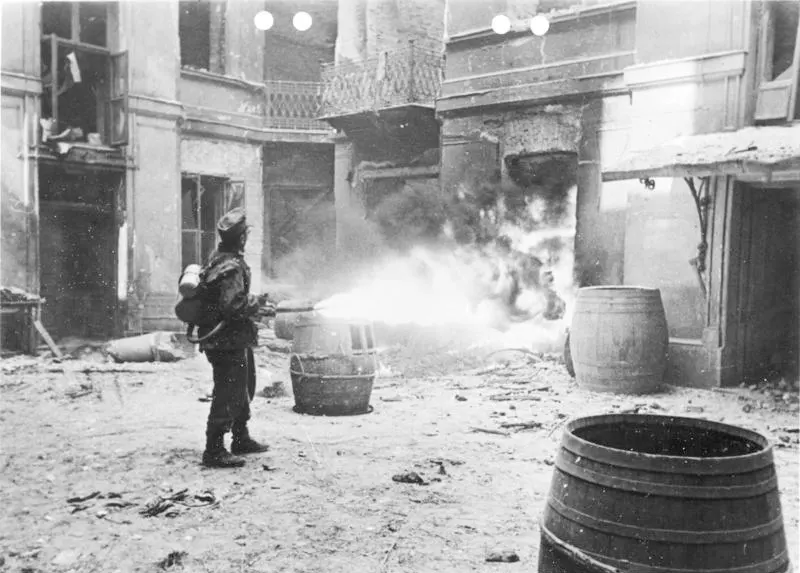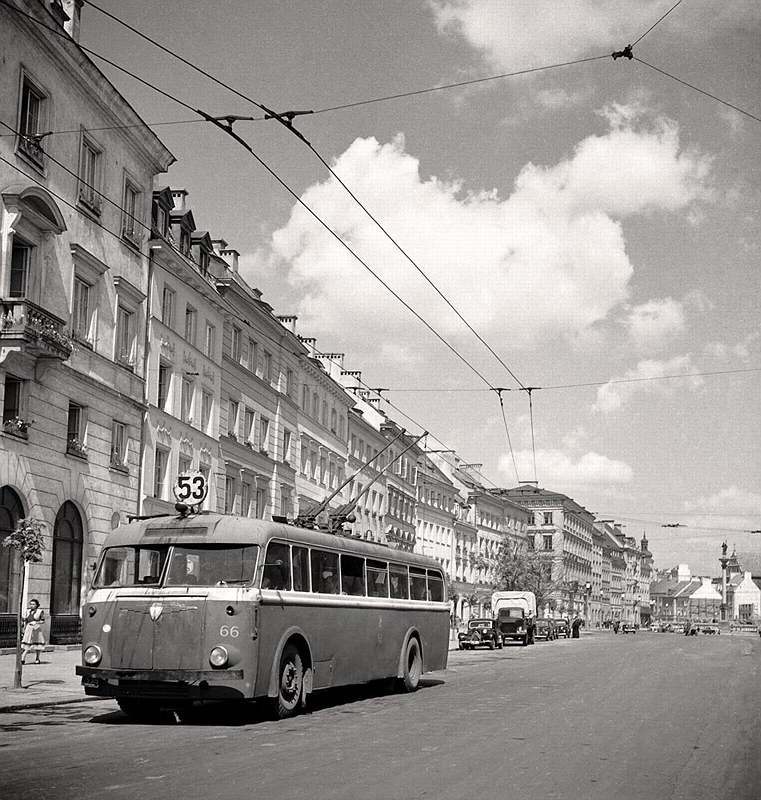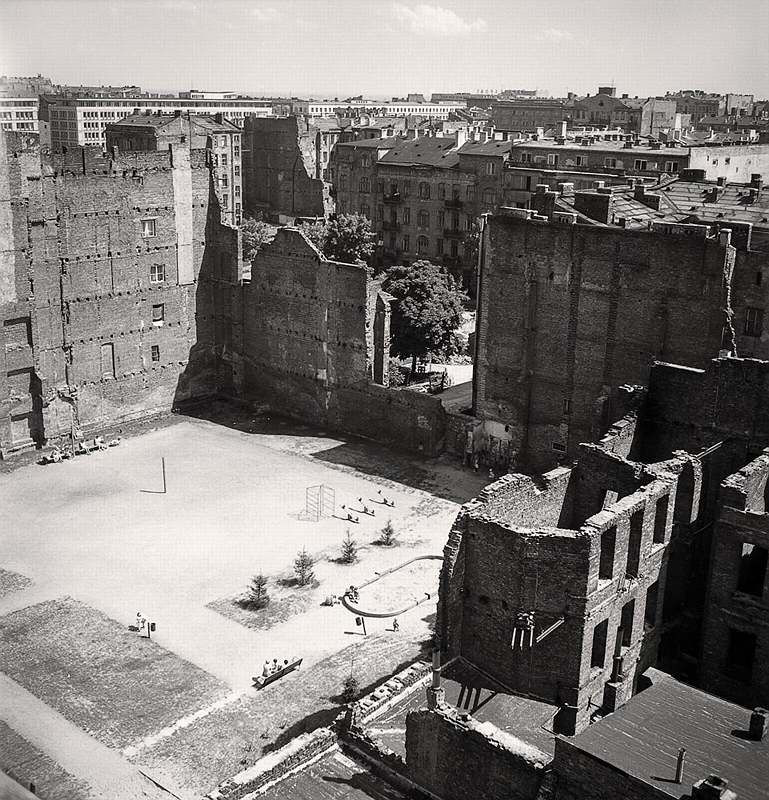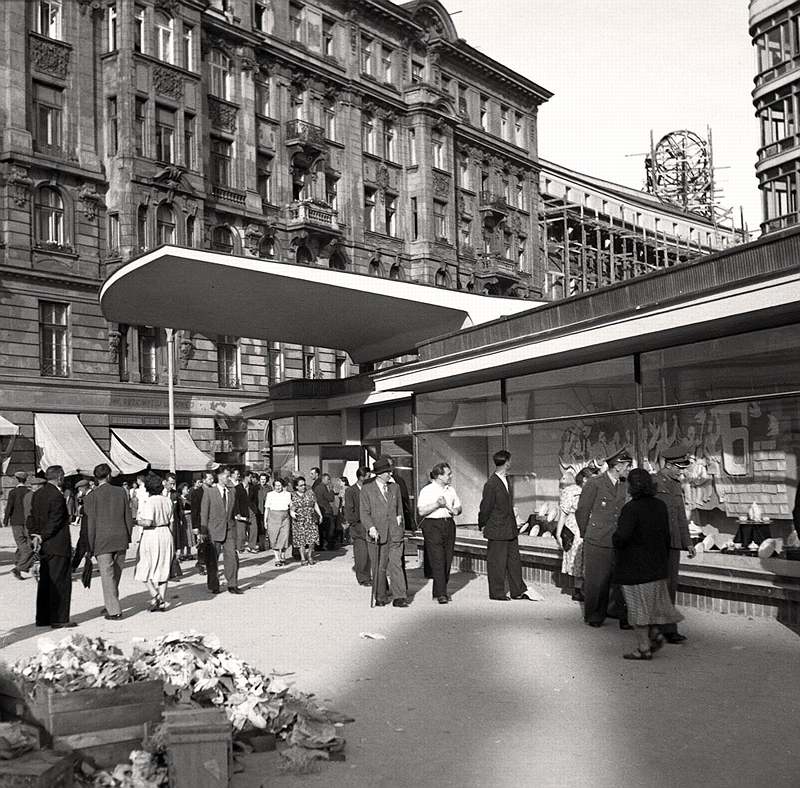
The destruction of Warsaw at the end of World War Two stands as one of the most tragic and devastating events in the history of the Second World War.
Once a city of great cultural and architectural significance, Warsaw was reduced to a pile of rubble and ashes after years of brutal German occupation and a subsequent failed uprising by the Polish Home Army.
The city’s rich heritage, which included a vibrant Jewish community, was almost entirely wiped out in the wake of the destruction, leaving a city in ruins and a people reeling from the horrors of war.
During World War II 84% of Warsaw was destroyed. These dramatic snaps in monochrome and color show the center of the city, including Śródmieście, Old Town, and the Jewish Ghetto.
The color photos were taken by New York photographer Henry N. Cobb during his stay in Warsaw, Poland in the summer of 1947.

Ruins of the Old Town Market Place in January 1945.
During the German occupation of Warsaw, the city was subjected to a brutal campaign of repression and subjugation.
The Jews of the city were rounded up and confined to a large ghetto in the city’s northwestern section, where they were forced to endure appalling living conditions, disease, and starvation.
Thousands died within the confines of the ghetto, while many others were shipped off to Nazi extermination camps in other parts of Poland.
The resistance to the German occupation began to gain momentum in the summer of 1944 when the Polish Home Army launched an uprising in the hopes of expelling the Germans before the arrival of Soviet troops.
The uprising was ultimately crushed by the German military, who carried out brutal reprisals against the civilian population, including the widespread destruction of the city.

Warsaw Old Town marketplace, 1945.
The German razing of the city had long been planned. Warsaw had been selected for destruction and major reconstruction as part of the Nazis’ planned Germanization of Central Europe, under the Nazi Generalplan Ost.
However, by late 1944, with the war clearly lost, the Germans had abandoned their plans of colonizing the East.
Thus, the destruction of Warsaw did not serve any military or colonial purpose; it was carried out solely as an act of reprisal.
German forces dedicated an unprecedented effort to razing the city, destroying 80–90% of Warsaw’s buildings, including the vast majority of museums, art galleries, theaters, churches, parks, and historical buildings such as castles and palaces.
They deliberately demolished, burned, or stole an immense part of Warsaw’s cultural heritage.

Royal Castle reduced to rubble.
By January 1945, between 85% and 90% of the buildings had been completely destroyed; this includes up to 10% as a result of the September 1939 campaign and following combat, up to 15% during the earlier Warsaw Ghetto Uprising, 25% during the Uprising, and 40% due to systematic German demolition of city after the uprising.
Material losses were estimated at 10,455 buildings, 923 historical buildings (94%), 25 churches, 14 libraries including the National Library, 81 primary schools, 64 high schools, the University of Warsaw, the Warsaw University of Technology, and most of the city’s historical monuments. Almost a million inhabitants lost all of their possessions.
The exact losses of private and public property, including pieces of art, other cultural artifacts and scientific artifacts, is unknown but must be considered substantial since Warsaw and her inhabitants were the richest and wealthiest Poles in pre-war Poland.

Marszałkowska Street in flames.
During the German suppression of the Warsaw Uprising of 1944, around 70 to 80% of libraries were carefully burned by the Brandkommandos (burning detachments), whose mission was to burn Warsaw.
In October 1944 the Załuski Library, the oldest public library in Poland and one of the oldest and most important libraries in Europe (established in 1747), was burned down.
Out of about 400,000 printed items, maps and manuscripts, only some 1,800 manuscripts and 30,000 printed materials survived.

Statue of Jesus Christ from the Holy Cross Church.
Despite the overwhelming destruction and the many obstacles faced in the aftermath of the war, the Polish people showed incredible resilience and determination in their efforts to rebuild Warsaw.
The task was enormous, requiring the clearance of rubble and debris, the rebuilding of infrastructure, and the provision of new housing for hundreds of thousands of homeless people.
The reconstruction effort was also complicated by the political situation in Poland, which was under Soviet control and facing significant economic challenges.

A German soldier sets fire to a building.
However, with support from the international community and the collective efforts of the Polish people, Warsaw was eventually rebuilt, and its historic Old Town and many other cultural landmarks were restored to their former glory.
In the years since the war, the city has continued to grow and thrive, becoming a vibrant and cosmopolitan center of art, culture, and commerce.
Today, the city stands as a testament to the human spirit, and the power of resilience and determination to overcome even the most devastating of circumstances.
The destruction of Warsaw, and the subsequent rebuilding of the city, serves as a reminder of the enduring legacy of war and conflict.
It is a sobering reminder of the terrible price paid by those caught in the crosshairs of violent conflict, and a testament to the courage and perseverance of those who strive to rebuild and renew in the face of adversity.

Aerial photograph of the destroyed Warsaw Ghetto.

Royal Castle near the Vistula River, 1948.
.jpg)
.jpg)
.jpg)
.jpg)
.jpg)
.jpg)
.jpg)
.jpg)
.jpg)
.jpg)
.jpg)
.jpg)
.jpg)
.jpg)
.jpg)
.jpg)
.jpg)
.jpg)
.jpg)
.jpg)
.jpg)
.jpg)
.jpg)
.jpg)
.jpg)
.jpg)
.jpg)
.jpg)
.jpg)
.jpg)
.jpg)
.jpg)








(Photo credit: Henry N. Cobb / Wikimedia Commons / Britannica / Pinterest / Flickr).
Updated on: May 3, 2023



